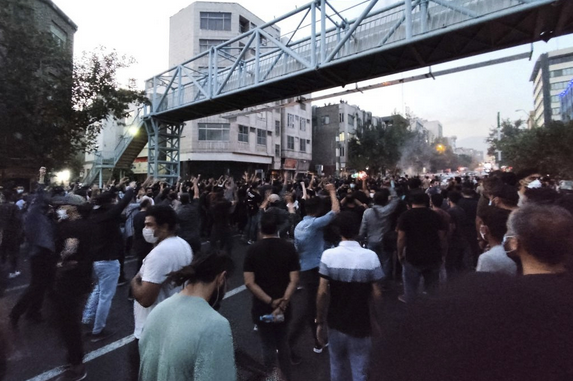by Majid Rafizadeh • Gatestone Institute • December 7, 2024
 Without the oppressive ruling mullahs, Iran could once again be a force for good, both domestically and globally. Freed from their brutal rulers, the Iranian people could channel their immense talent and potential into rebuilding their nation as a thriving hub of innovation, culture and prosperity. Pictured: Iranians protest the murder of 22-year-old Mahsa Amini, murdered by police while in custody, in Tehran on September 21, 2022. (Photo by AFP via Getty Images)
Without the oppressive ruling mullahs, Iran could once again be a force for good, both domestically and globally. Freed from their brutal rulers, the Iranian people could channel their immense talent and potential into rebuilding their nation as a thriving hub of innovation, culture and prosperity. Pictured: Iranians protest the murder of 22-year-old Mahsa Amini, murdered by police while in custody, in Tehran on September 21, 2022. (Photo by AFP via Getty Images)
- Unlike Iran’s regime, the country’s people are overwhelmingly pro-American and pro-Jewish — sentiments rooted in a historical alliance that made Iran the closest ally of both Israel and the United States before the mullahs came to power. The regime’s anti-American and antisemitic stance is an affront to the true nature of its citizens, who yearn for peace and global partnership.
- Without the oppressive ruling mullahs, Iran could once again be a force for good, both domestically and globally. Freed from their brutal rulers, the Iranian people could channel their immense talent and potential into rebuilding their nation as a thriving hub of innovation, culture and prosperity. This revival would not only uplift Iran but also finally bring peace and stability to the Middle East and beyond, setting an example of what a liberated, flourishing nation can achieve.
- Finally, there should be no negotiations, deals or trades with the regime. Such engagements only empower and legitimize the mullahs while undermining the people’s struggle for freedom.
- The time has come to support the cause of the Iranian people and ensure that this great nation, with its rich history and boundless potential, rises once more – without mullahs.
Historically known as Persia, Iran stands as one of the most illustrious civilizations in human history. For centuries, it was a beacon of cultural, scientific and political advancements, earning respect and admiration across the globe. This legacy of greatness persisted until 1979, when a group of Islamic fundamentalists, obsessed with religion, hijacked a revolution that drastically altered the nation’s trajectory.
The mullahs seized control, installing a theocratic Islamist regime that has since ruled with an iron fist — arguably one of history’s most brutal and oppressive reigns. The proud heritage of a nation that once symbolized enlightenment and progress has been overshadowed by a reign marked by suppression, regression and fear.



https://www.memri.org/reports/us-will-not-need-be-involved-war-if-it-supports-secular-ethnic-groups-against-iranian